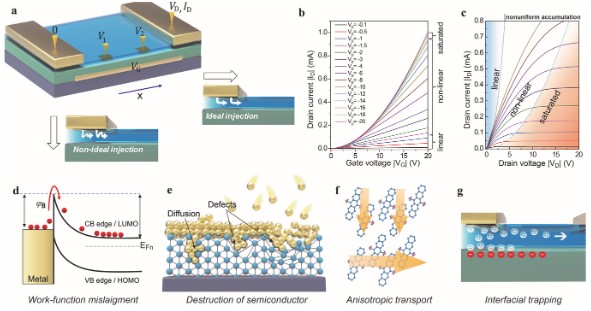A General Approach to Probe Dynamic Operation and Carrier Mobility in Field-Effect Transistors with Nonuniform Accumulation
- 저자
- Chuan Liu*, Changdong Chen, Xiaojie Li, Sujuan Hu, Chenning Liu, Kairong Huang, Fuhua Dai, Baijun Zhang, Xuying Liu, Takeo Minari, Yong‐Young Noh, Jun Chen
- 저널명
- Advanced Functional Materials, 29, 29, 1901700 (2019)
- 년도
- 2019
- Link
- https://doi.org/10.1002/adfm.201901700 620회 연결
[Abstract]
Revealing the intrinsic electrical properties is the basis of understanding new functional materials and developing their applications. However, in nonideal field-effect transistors (FETs), conventional current–voltage characterizations do not accurately probe charge transport, particularly for newly developed semiconductors. Here, a generalized gated four-probe (G-GFP) technique is developed, which detects dynamic changes in carrier accumulation and transport. The technique is suitable for exploring the intrinsic properties of semiconductors in FETs with arbitrary contacts and in any operational regimes above the threshold. Application to simulated transistors confirms its accuracy in probing the evolution of channel potential, drift field, and gate-dependent carrier mobility for devices with a contact-limited operation and disordered semiconductors. Comparative experiments are performed based on FETs with various materials, device structures, and operational temperatures. The G-GFP technique proves to exclude the various injection properties, to detect in situ how carriers are accumulated, and to clarify carrier mobility of the semiconductors. In particular, the well-known “double-slope” features in the current–voltage relations are controllably generated and their origins are identified. The approach could be used to explore electronic properties of newly developed materials such as organic, oxide, or 2D semiconductors.
- 이전글Redox-state modulated ORR activity of Cd-based Prussian blue analog frameworks transformed via anion exchange with controlled redox-state from CdCO3 cuboids 24.12.15
- 다음글Polymer Electrolyte Blend Gate Dielectrics for High-Performance Ultrathin Organic Transistors: Toward Favorable Polymer Blend Miscibility and Reliability 24.12.15
